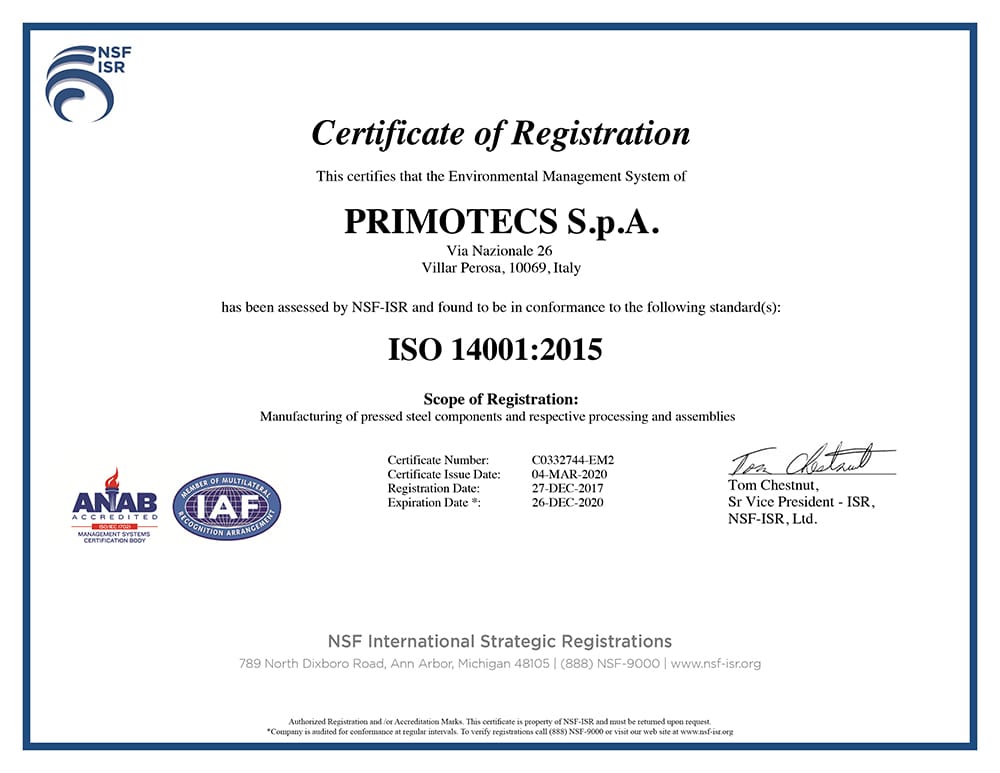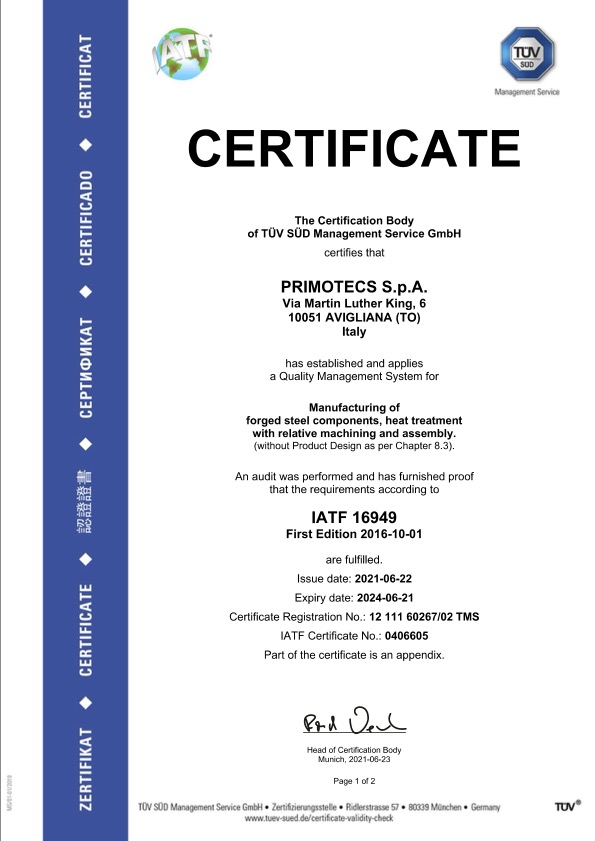Driveline
We develop and supply complex driveline components, such as CV-joints, tripod housings, inner- & outer-rings for wheel-hubs. Thanks to our optimized manufacturing process and the combination of sheet metal and solid design processes, we are now successfully mass-producing joint components, notable for their small size as well as their low weight and noise-optimized design features.
Our expertise of combined hot, warm and cold forming procedures, complemented by our processing and assembly facilities, allows us to be one appreciated suppliers of CV joints.
Constant velocity-joint

Outer race are the constant velocity outer joints of the constant velocity shaft and enable a high bending angle during torque transmission to the wheel hub.
Material used is induction hardening steel and process used is mainly warm forging combined with cold calibration to achieve a near-to-shape ball tracks geometry and in few cases an additional hirth gear for the newest.
Tripod housings

Tripod housing is a type of joint making the liaison between the gear box and the constant velocity shaft. It works within a less regular range than many other types of joints but allows axial movement that enables length compensation.
Material is induction hardening steel and are produced by warm forging with cold calibrated raceways ready for hardening. The inner geometry is optimized in codesign with the customer in such a way that hard machining is not necessary.
Drive-wheel | inner ring 3rd generation for wheel hub

The wheel hub inner ring holds wheel and brake disk and transfers the driving power received fromthe CV-joint to the wheel. Due to the high rotary bending and bearing loads, it is mounted into an anti- friction bearing made of an inner bearing ring and the wheel hub outer ring itself. Inductive hardening of the ball bearing surfaces. Fiber alignment is achieved by forging processes close to the contour along the ball tracks.
Drive-wheel | outer ring 3rd generation for wheel hub

The wheel hub outer ring, fixed on the chassis, is the outer part of the anti-friction bearing. Hot forging followed by a heat treatment (mostly globular annealing) to stabilize the metallurgical structure, followed by a complete machining and in few cases local hardening which gives the final and definitive metallurgical characteristics.
Idle-wheel | outer ring 2nd generation for wheel hub

The wheel hub outer ring holds wheel and brake disk and does not transfer any power, therefore the name “idle” wheel. Due to the high rotary bending and bearing loads, it is also mounted into an anti- friction bearing made of inner bearing rings mounted on the wheel spindle and the wheel hub outer ring itself.
Fastener | axle nut
 The axle nut blocks the wheel hub on the wheel axle. These special nuts are used to having an auto-blocking function (like nylon ring or segments) and are mounted according to precise torque and load specifications.
The axle nut blocks the wheel hub on the wheel axle. These special nuts are used to having an auto-blocking function (like nylon ring or segments) and are mounted according to precise torque and load specifications.
Bearing-ring | external ring for bearing
 The outer ring is the external part of the bearing (ball / tapper) and is associated to the inner bearing ring. They are mainly used for Generation I wheel hub assemblies
The outer ring is the external part of the bearing (ball / tapper) and is associated to the inner bearing ring. They are mainly used for Generation I wheel hub assemblies
Bearing-ring | internal ring for bearing
 The inner ring is the internal ring of the bearing (ball / tapper) and is associated to the outer bearing ring. They are used for Gen I, II and III wheel hub assemblies.
The inner ring is the internal ring of the bearing (ball / tapper) and is associated to the outer bearing ring. They are used for Gen I, II and III wheel hub assemblies.
Engine
For the engine-segment, we develop and supply components, such as connecting rods and specifically for the e-mobility rotor-shafts.
Conrod

The connecting rod (conrod) is an engine component which, together with the crank, converts the reciprocating motion of the pistone into the rotation of the crankshaft. They are commonly made from high-strength steel and are designed to withstand dynamic stresses from combustion and piston movement. Weight-optimized design through simulation of manufacturing processes. High vertical range of manufacture through forming and finishing.
Pulley
 The engine pulley is a wheel mounted to the engine that guides or drives a belt, part of a system that powers peripherical devices within the engine compartment (air conditioning, engine timing etc.). Some pulleys, often known as idler pulleys, simply keep tension on the belt and help guide the belt properly through the serpentine system.
The engine pulley is a wheel mounted to the engine that guides or drives a belt, part of a system that powers peripherical devices within the engine compartment (air conditioning, engine timing etc.). Some pulleys, often known as idler pulleys, simply keep tension on the belt and help guide the belt properly through the serpentine system.
Cam Pulley
 The cam pulley is a part of the timing system in an engine used to control the rate of rotation of the camshaft, component that controls the poppet valves responsible for air intake and exhaust in the cylinders. The cam pulley articulates with the timing chain to rotate the camshaft in synchronicity with the crankshaft. Hot forging followed by isoterm annealing and high precision turning with tight tolerances.
The cam pulley is a part of the timing system in an engine used to control the rate of rotation of the camshaft, component that controls the poppet valves responsible for air intake and exhaust in the cylinders. The cam pulley articulates with the timing chain to rotate the camshaft in synchronicity with the crankshaft. Hot forging followed by isoterm annealing and high precision turning with tight tolerances.
E-Mobility
Original-equiment-manufacturer are confronted to new challenges for e-mobility. We are striving to support best with new solutions. Solutions for power transmission within electric vehicles are also included in our scope of applications. Our technologies allow us to build rotor shafts, as well as other key components such as input shafts and hubs for hybrid modules.
Rotor-Shaft

The rotor-shaft of electric motor, designed on the basis of static and dynamic loadings, has to transmit the high torque of the electric motor in a precise and stable way. This is an increasing new product group that we are developing with our customers. They can be produced by warm or cold forging, or a combination of these two processes, followed by heat treatment on request.
Transmission
We are producing gears, input- and output shafts for manual and Dual-Clutch-Transmissions.
Inputshaft gearbox engine side

These shafts cover a large range of input shafts for manual gear boxes as well as for Dual-Clutch-Transmission (DCT). They receive directly the engine torque from the clutch and transmit it through various gears to the output shaft. Cold forging followed by a heat treatment (mostly isoterm annealing) to achieve the definitive metallurgical characteristics.
In few cases, undercut can be obtained directly by forging or by assembling two parts by friction welding. Warm forging can be used in case of shafts with large flange like in DCT.
Output shaft gearbox differential side

These shafts cover a large range of output shafts for manual gear boxes as well as for Dual-Clutch-Transmission (DCT). They receive the transmission torque coming from the inputshaft through various gear and transmit the final demultiplied torque to the crown of the differential case.
Cold forging followed by a heat treatment (mostly isoterm annealing) to achieve the definitive metallurgical characteristics. Warm forging can be used in case of shafts with large flange like in DCT.
Gear | speed gear
 These gears (spur gear, reverse gear, sleeve,…) mounted either on input shaft as well as on output shaft, demultiply and transmit the torque according to the selected speed coming from the engine down to the crown of the differential case. Hot forging followed by a heat treatment (mostly isoterm annealing) to achieve the definitive metallurgical characteristics.
These gears (spur gear, reverse gear, sleeve,…) mounted either on input shaft as well as on output shaft, demultiply and transmit the torque according to the selected speed coming from the engine down to the crown of the differential case. Hot forging followed by a heat treatment (mostly isoterm annealing) to achieve the definitive metallurgical characteristics.
Certifications
Quality Management System
Our processes meet strict quality criteria according to the requirements of the certified Quality Management System.
Environment
We are committed to follow continuous environmental activity for minimizing the environmental impacts of our processes.

















